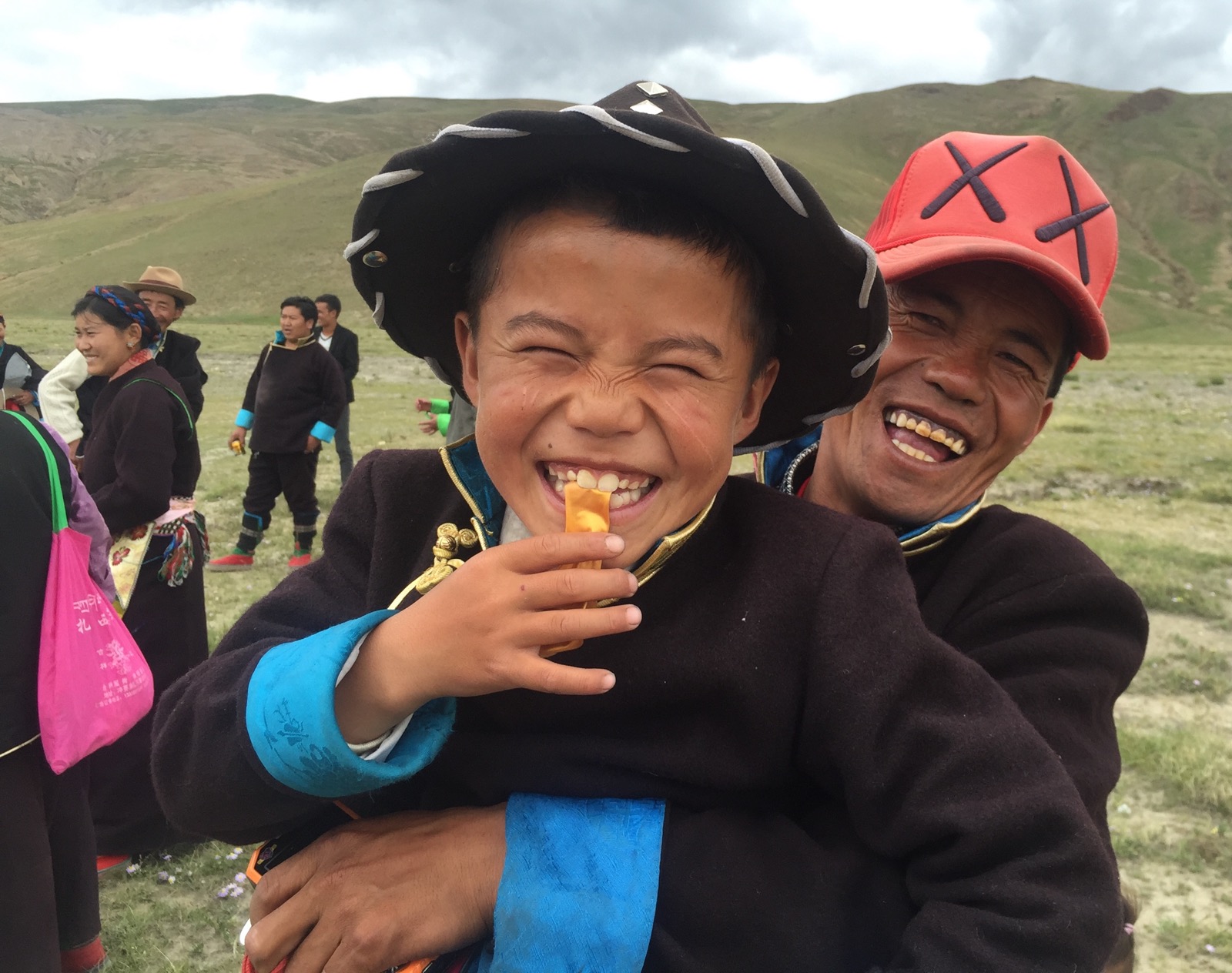Our time in China began in Hong Kong and ended in Tibet, where Mount Everest marks the border with Nepal. The Tibet Autonomous Region brought a distinct face of China into focus. It stirred intense and conflicting emotions within us.
Tibet is breathtakingly beautiful and steeped in spirituality. When we arrived in Lhasa, the capitol, we joined the early morning kora around the revered Jokhang temple. Tibetans walk this circuit together each day as the mists rise over the Portola Palace, which is built magestically into the steep slopes at the outskirts of town, and easily visible from the Jokhang courtyards. The smell of incense and burning juniper needles wafts through the air. Prayer wheels spin, whispering the mantras that their owners chant and sing. In front of the temple, people of all ages rhythmically prostrate, generating the energy unique to those moments when an entire community shares in a tradition practiced for hundreds of years.
Later, at the foot of Mount Everest, we found a moment of complete stillness in a cave dedicated to meditation since the 8th century.
 Enjoying a village harvest fair.
Enjoying a village harvest fair.
And, yet, never before have we felt our own freedom so constrained. We arrived in Lhasa near the 50th anniversary of the Autonomous Region’s creation, following its “peaceful liberation” by China. But in reality, Tibet is neither autonomous nor liberated. Just the opposite. Extensive permits are required just to enter region; they took weeks to obtain and were checked again and again before we could board our train to Lhasa. Once in Tibet, our movements were tightly confined: foreigners must have a guide and private driver – even if traveling by bicycle or on foot. In Lhasa, police checkpoints met us at every turn. Cameras on nearly every lightpost tracked our movements through the old city.
Beyond Lhasa, police checkpoints chop the roads into short stretches. Papers are time-stamped as you move through these stations. Arrive at a checkpoint too soon and you’ll be fined for exceeding the speed limit; arrive too late and the police will question where you’ve been.
To gaze upon Mount Everest, we presented our passports and permits to soldiers at a military checkpoint. Even with our permits, we were prohibited from walking any of the trails at the foot of the great mountain, lest we stage a protest for Tibetan liberation at this world landmark.
Beyond the explicit prohibitions, a shadow of uncertainty extended over our day-to-day activities and self-censorship set in, fueled by the fear of endangering the Tibetans around us. Stories abound of guides being detained and tour companies losing their licenses when their foreign parties break some prohibition or speak out of turn and overheard by the wrong person.
Still, at the end of the day, we have American passports, so we can leave when we want. For all the numerous restrictions applied to us, the ones imposed on the Tibetans themselves are far more confining. And we can only imagine how the omnipresence of the Chinese police and military affects every decision they make and everything they say.
Under Chinese rule, the land of Seven Years in Tibet is slowly disappearing. During the Cultural Revolution, the Red Guard took sledgehammers to the holiest of temples; they painted Chinese characters over depictions of Tibetan gods. (To be fair, they did the same to cultural relics in China as well.)
Leading up to and during this upheaval, Tibet’s educated elites fled by the thousands; the Dalai Lama and Tibet’s greatest spiritual teachers now live in India and the West. Numbers have dwindled at monasteries as monks were frequently punished for being at the forefront of protest. Burdensome paperwork frustrates the enrollment of new recruits. China has banned the celebration of many of Tibet’s great festivals. Han Chinese have moved to Tibet in large numbers, changing the makeup of Lhasa.
The Dalai Lama has been a powerful advocate for Tibet even in exile, but he is now 80 years old. The Tibetans believe that when he dies, he will be reincarnated as the nation’s next Dalai Lama. But – even if China resists the temptation to interfere with the selection of Tibet’s next leader – the successor will be but a child for years.
Even in the face of all this, it’s impossible to ignore the positive impacts that Chinese-funded development has had in Tibet. For example, before the 1950s, Tibet had virtually no paved roads. Since then, China has built miles and miles of world-class highways, which speed the travel of commerce and bring Tibetans from across this vast land closer together. Tibet is beautiful in its ancient traditions, but it’s dangerous to romanticize poverty. Of course, these same roads also carry huge Chinese military convoys throughout Tibet.
 Harvesting barley fields, by hand.
Harvesting barley fields, by hand.
So are China’s hundreds of billions of yuan in investment present or poison? Tibetans have to wrestle with this question every day.
For example, in Shigatse, the area’s second largest city, it seems that all but the oldest generation of Tibetans have moved into new homes in Chinese-built housing complexes. These homes are more likley to have basic amenities like electricity, and perhaps even indoor plumbing. As a result, when we walked through the old Tibetan neighborhood, the shops were shuttered, the streets mostly empty but for trash and stray dogs.
But these newer homes undoubtedly come with strings attached, explicit and implicit. For example, in these newer developments, small Chinese flags fly from every doorpost. We don’t know for sure that these flags are mandatory, we only know that we saw far, far more Chinese flags in Tibet than in any other part of China – and that this visible display of Chinese patriotism seemed more than a little out of step with the sentiment of most Tibetans about the Chinese presence in their former country.
Tibet is a beautiful, sad, complicated place. And it is changing fast.